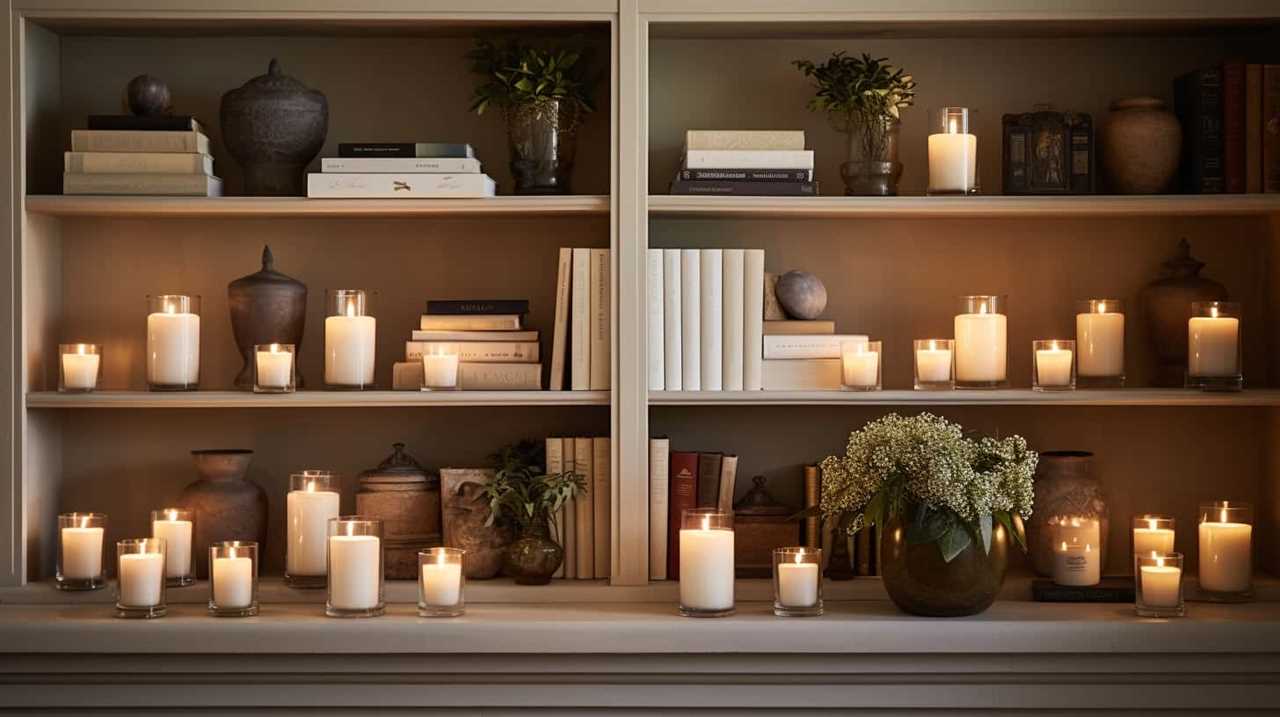Have you ever thought about how you can reuse your Bath and Body Works candle containers? Well, you’re in luck! This tutorial will show you different creative and practical ways to give those beautiful jars a fresh new purpose.
With a little creativity and some DIY skills, you can transform these jars into useful items that will not only help you organize your space but also add a touch of elegance to your home. From makeup brush holders to kitchen storage jars, the possibilities are endless.
So, let’s dive in and discover the art of repurposing Bath and Body Works candle jars!
Key Takeaways
- Bath and Body Works candle jars can be repurposed for home decor and organization, such as using them as makeup brush holders, mini planters, bathroom storage containers, and DIY candle holders.
- These candle jars can also be utilized for office organization, serving as desk organizers, cable management tools, herb or spice containers, DIY air fresheners, and craft supply storage.
- They can be repurposed as travel and toiletry containers, making them ideal for storing travel-sized toiletries and serving as portable shampoo bottles.
- Bath and Body Works candle jars are also suitable for DIY bath and beauty products, such as using them as jars for DIY bath salts or containers for homemade lip balm. Additionally, they can be repurposed for jewelry organization and kitchen storage, serving as jewelry organizers and kitchen storage jars.
Makeup Brush Holder
To repurpose Bath and Body Works candle jars, we love using them as a makeup brush holder. Not only does it add a touch of elegance to our bathroom counter decor, but it also helps with makeup brush organization.
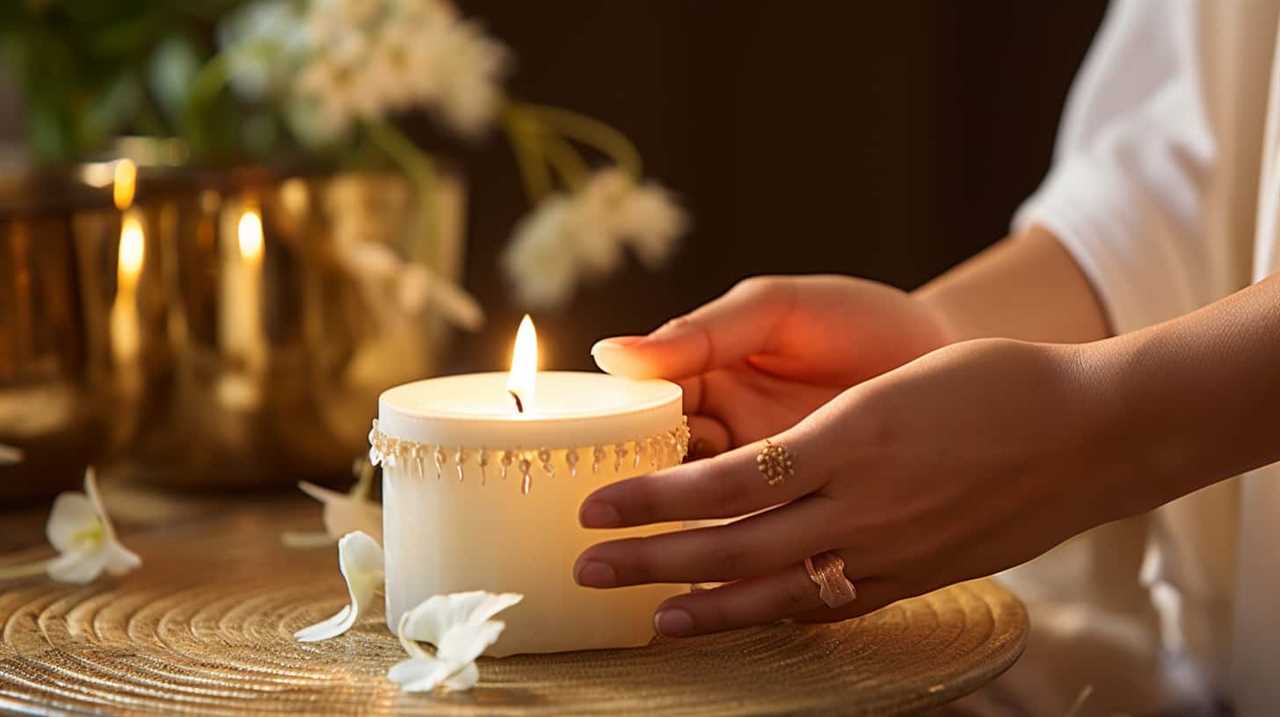
The cylindrical shape of the jar perfectly accommodates different sizes and lengths of brushes, keeping them upright and easily accessible. Plus, the clear glass allows us to see all our brushes at a glance, making it easier to find the one we need.
To make it even more functional, we suggest adding decorative beads or stones at the bottom of the jar to help hold the brushes in place.
This simple and practical DIY project is a great way to repurpose candle jars and keep our makeup brushes organized in style.
Mini Planters
We often find ourselves repurposing Bath and Body Works candle jars as mini planters. These jars make perfect containers for small plants like mini succulent pots. The transparent glass allows us to admire the beauty of the plants while adding a touch of elegance to our homes.

To create a hanging planter, we can attach a string or a small chain to the jar lid and hang it from a hook or a rod. This not only saves space but also adds a unique and stylish element to our decor.
Mini planters are a great way to bring nature indoors and create a calming and soothing atmosphere.
Now, let’s move on to the next section and explore how these candle jars can be repurposed as bathroom storage containers.
Bathroom Storage Containers
One option for repurposing Bath and Body Works candle jars is to use them as practical bathroom storage containers. These jars are the perfect size for storing various items in the bathroom, such as cotton balls, q-tips, and even makeup brushes. By removing the labels and cleaning out the jars, you can create stylish and functional storage solutions for your bathroom.
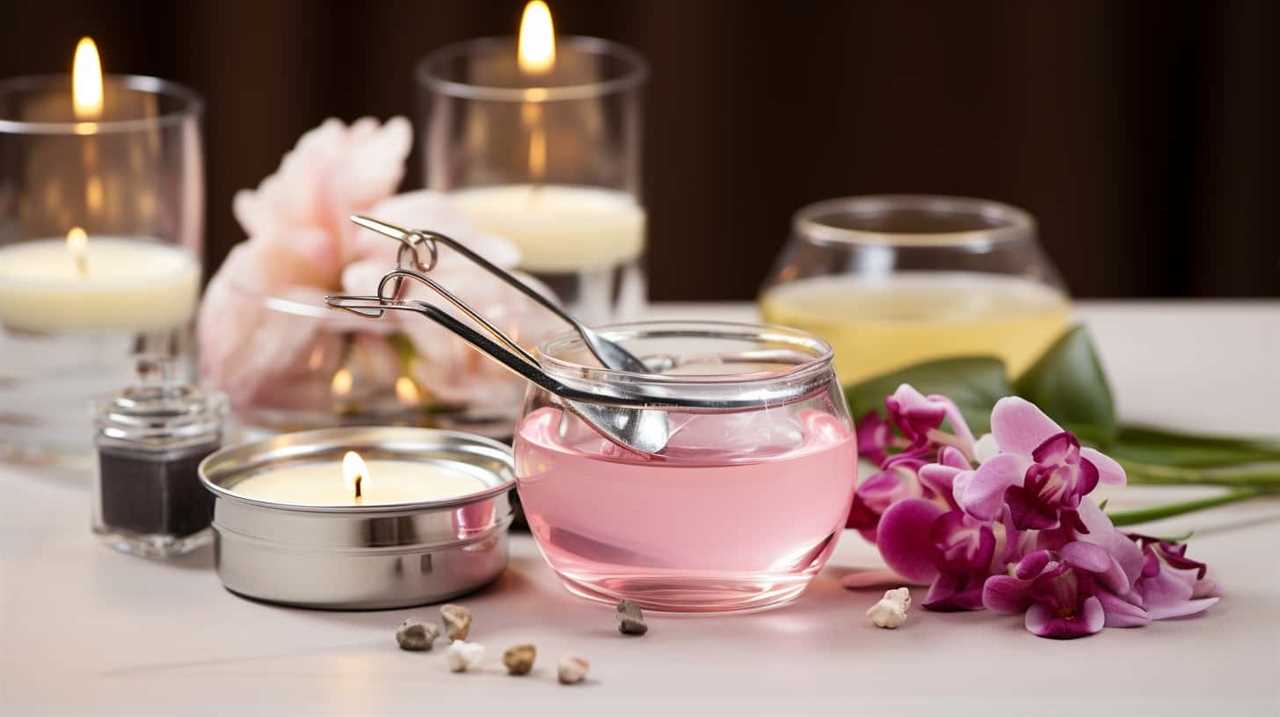
To give you an idea of how versatile these candle jars can be, here is a table showcasing different ways you can use them for bathroom organization:
| Jar Size | Storage Ideas | Benefits |
|---|---|---|
| Small | Makeup storage | Keeps your makeup organized and visible |
| Medium | Hair accessories storage | Easy access to hair ties and bobby pins |
| Large | Toiletry storage | Neatly stores your travel-sized products |
DIY Candle Holders
Let’s get creative with our candle holders!
Reusing Bath and Body Works candle jars allows us to create unique designs that add a touch of personal style to our homes.
Unique Jar Designs
To create unique candle holders, consider repurposing Bath and Body Works candle jars in creative and innovative ways. These jars can be transformed into stylish makeup storage containers or decorative pieces for your home decor. With a little imagination and some simple DIY techniques, you can turn these jars into beautiful and functional candle holders that will add a touch of elegance to any room.

One idea is to paint the jar with your favorite color and add decorative accents such as ribbons or beads. You can also use stencils to create intricate designs on the jar’s surface. Another option is to attach a handle to the jar, turning it into a hanging candle holder that can be placed anywhere in your home.
By repurposing Bath and Body Works candle jars, you can create unique and personalized candle holders that reflect your personal style and taste.
Now, let’s explore the next section about upcycling candle containers.
Upcycling Candle Containers
We can repurpose Bath and Body Works candle jars into unique and personalized candle holders that reflect our personal style and taste.
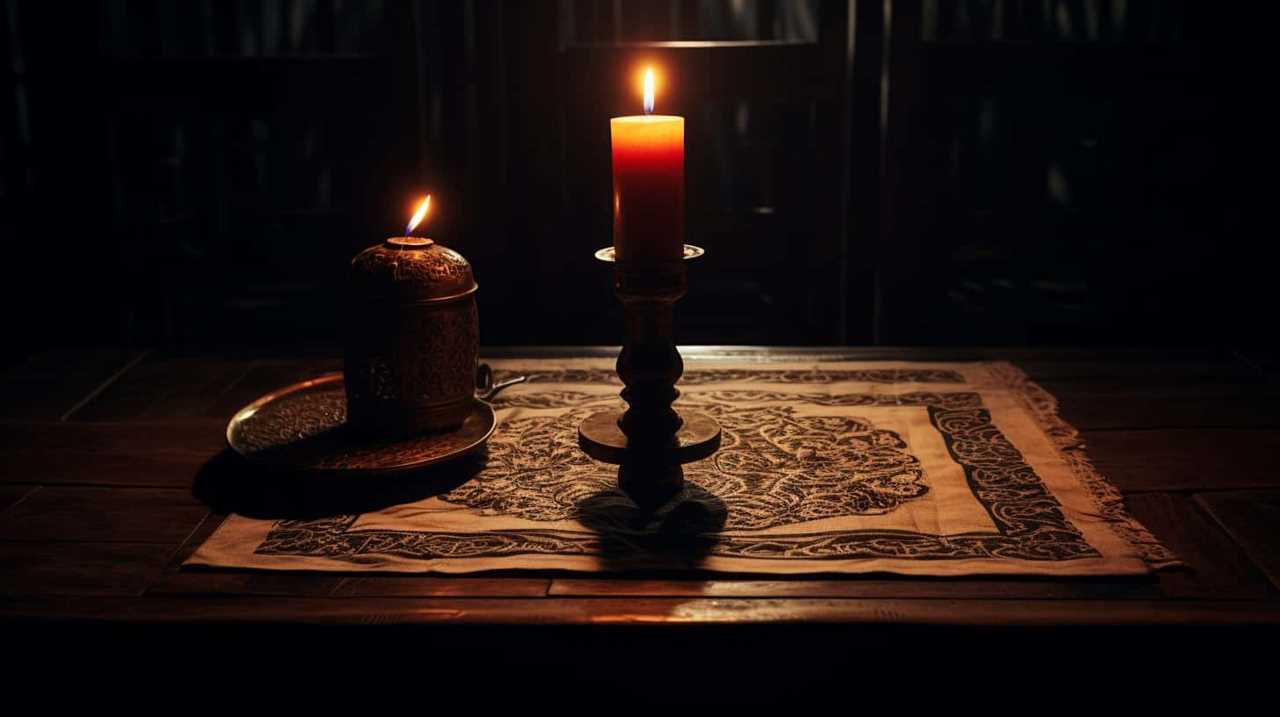
Once the candle has burned down and the jar is empty, we can clean it out and transform it into a functional and decorative piece.
One idea is to use the jar as a makeup brush organizer. Simply place your brushes inside the jar and they’ll be neatly organized and easy to access.
Another option is to turn the jar into a kitchen utensil holder. It can hold all your cooking utensils while adding a touch of charm to your kitchen.
By repurposing these candle jars, we not only reduce waste but also create practical and stylish solutions for our homes.

Now, let’s move on to the next section and explore creative ways to display our repurposed candle holders.
Creative Candle Display
For our creative candle display, we can explore unique and personalized ways to showcase our repurposed Bath and Body Works candle jars.
One idea is to use them as makeup brush organizers. Simply clean out the jar, remove any remaining wax, and place your makeup brushes inside. This not only keeps your brushes organized and easily accessible but also adds a touch of elegance to your vanity or bathroom countertop.
Another option is to turn the candle jar into a kitchen countertop decor piece. Fill it with small decorative items like colorful spices, coffee beans, or even small fruits like lemons or limes. This adds a pop of color and style to your kitchen while keeping your countertop clutter-free.
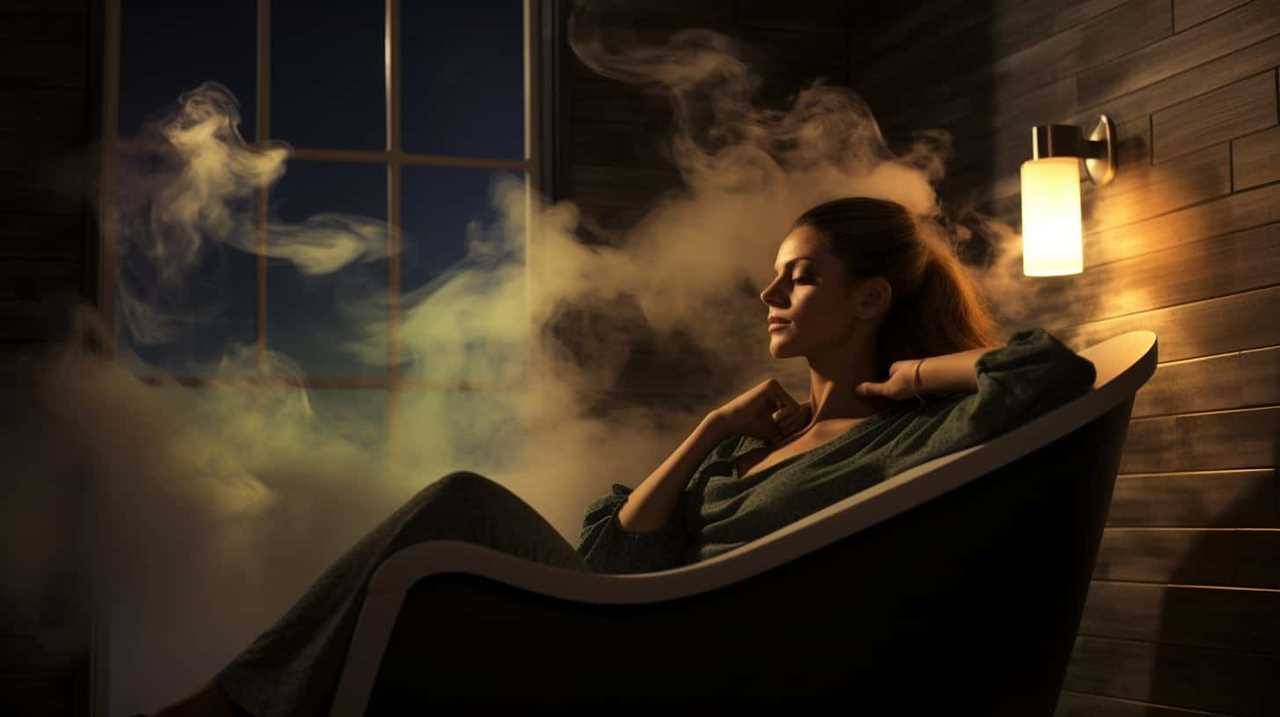
Get creative and let your imagination run wild with these repurposed candle jars!
Office Organization
Our approach to office organization involves utilizing the empty Bath and Body Works candle jars. These versatile jars can be repurposed as stylish office decorations and functional desk accessories.
Here are some creative ways to use them:
- Desk Organizer:
- Use a larger candle jar to hold pens, pencils, and markers.
- Place a smaller jar on your desk to store paperclips, binder clips, and other small office supplies.
- Cable Management:
- Arrange your charging cables neatly inside a candle jar to prevent them from tangling.
- Label each jar with the type of cable it contains for easy identification.
By repurposing these candle jars, you can transform your office space into a well-organized and visually appealing environment. Not only will you have a clutter-free desk, but you’ll also add a touch of creativity and style to your workspace.
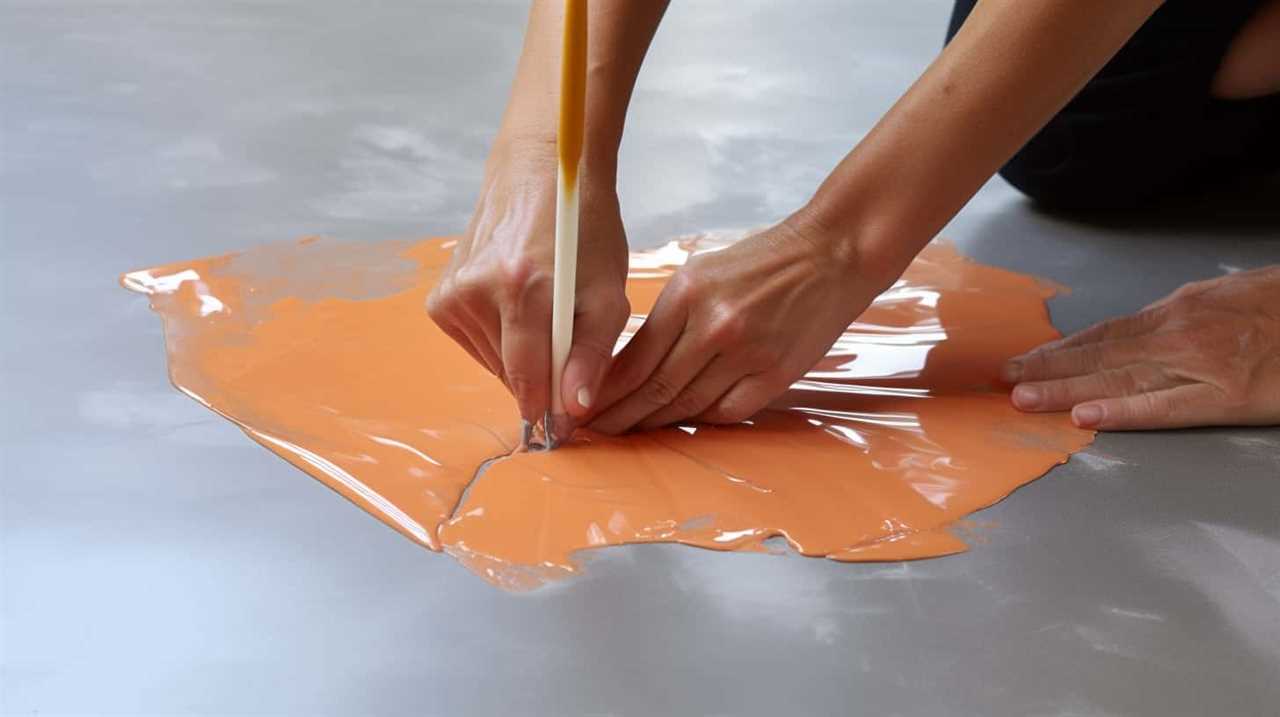
Master the art of office organization with these simple yet effective ideas.
Herb or Spice Containers
To maximize the functionality of Bath and Body Works candle jars, we can repurpose them as convenient herb or spice containers. By utilizing these jars, we can create our own herb garden or spice rack, adding a touch of practicality and creativity to our kitchen. The transparent nature of the jars allows us to easily identify the contents, making it effortless to find the desired herb or spice while cooking. To engage our audience, we have created a table below showcasing different herbs and spices that can be stored in these repurposed jars.
| Herb or Spice | Description | Usage |
|---|---|---|
| Basil | A fragrant herb commonly used in Italian cuisine. | Ideal for pasta sauces and salads. |
| Cumin | A spice with a warm, earthy flavor often found in Indian and Mexican dishes. | Perfect for adding depth to curries and chili. |
| Rosemary | A woody herb with a pine-like aroma, popular in Mediterranean cooking. | Great for seasoning roasted meats and potatoes. |
Repurposing Bath and Body Works candle jars as herb or spice containers not only helps us organize our kitchen, but also adds a touch of charm and functionality to our cooking space.
DIY Air Fresheners
Let’s explore some creative ways to make our own air fresheners using the empty Bath and Body Works candle jars.
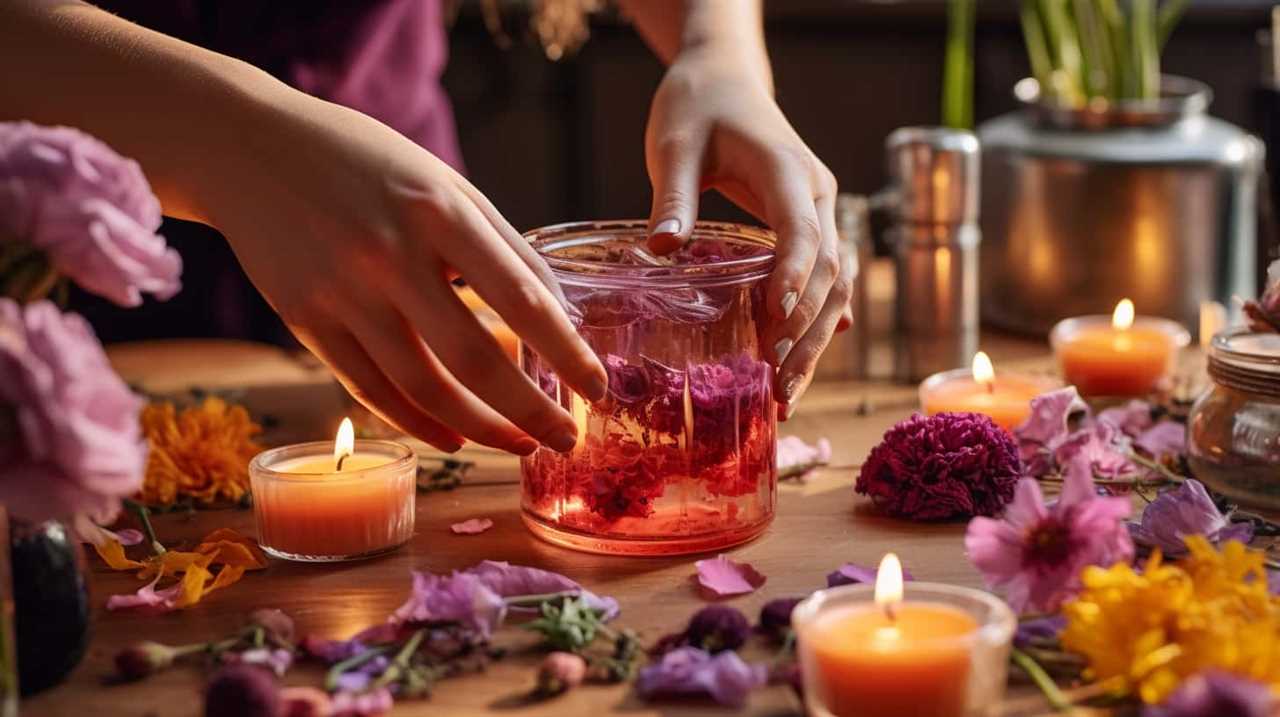
One option is to create essential oil blends by mixing different scents to create a personalized fragrance.
Another option is to use natural fragrance options like dried flowers, herbs, or citrus peels. These options not only freshen the air but also add a touch of nature to our homes.
Lastly, choosing eco-friendly alternatives such as bamboo charcoal or homemade potpourri can help reduce waste and promote a more sustainable lifestyle.
Essential Oil Blends
With just a few simple steps, we can transform our Bath and Body Works candle jars into delightful DIY air fresheners using essential oil blends. Here’s how:

- Clean the candle jar thoroughly to remove any remaining wax residue.
- Fill the jar with a blend of essential oils of your choice. Some popular options include lavender and chamomile for a calming scent, or lemon and peppermint for an energizing aroma.
By using essential oil blends, we can create natural fragrance options that not only freshen up our homes but also provide various therapeutic benefits. Essential oils are derived from plants and offer a wide range of scents to suit our preferences. Plus, they’re free from synthetic chemicals commonly found in commercial air fresheners, making them a healthier choice for our living spaces.
Now let’s explore some other natural fragrance options that can elevate the ambiance of our homes.
Natural Fragrance Options
We can explore various natural fragrance options to create DIY air fresheners that elevate the ambiance of our homes.
One option is to make herbal potpourri using dried flowers and herbs. Simply gather your favorite fragrant plants like lavender, rosemary, and mint, and let them dry completely. Once dried, mix them together and place them in decorative bowls or sachets to release a gentle aroma throughout your space.

Another option is to create homemade scented sachets using ingredients like dried citrus peels, cinnamon sticks, and cloves. These sachets can be placed in drawers, closets, or even under your pillow for a subtle and refreshing scent.
By using these natural fragrance options, we can create a welcoming and soothing atmosphere in our homes.
Now, let’s explore some eco-friendly alternatives to commercial air fresheners.
Eco-Friendly Alternatives
To create a more eco-friendly and sustainable home environment, we can explore DIY air fresheners as alternatives to commercial products. Making your own air fresheners not only reduces waste but also allows you to control the ingredients and avoid harmful chemicals. Here are two simple and effective DIY air freshener ideas:
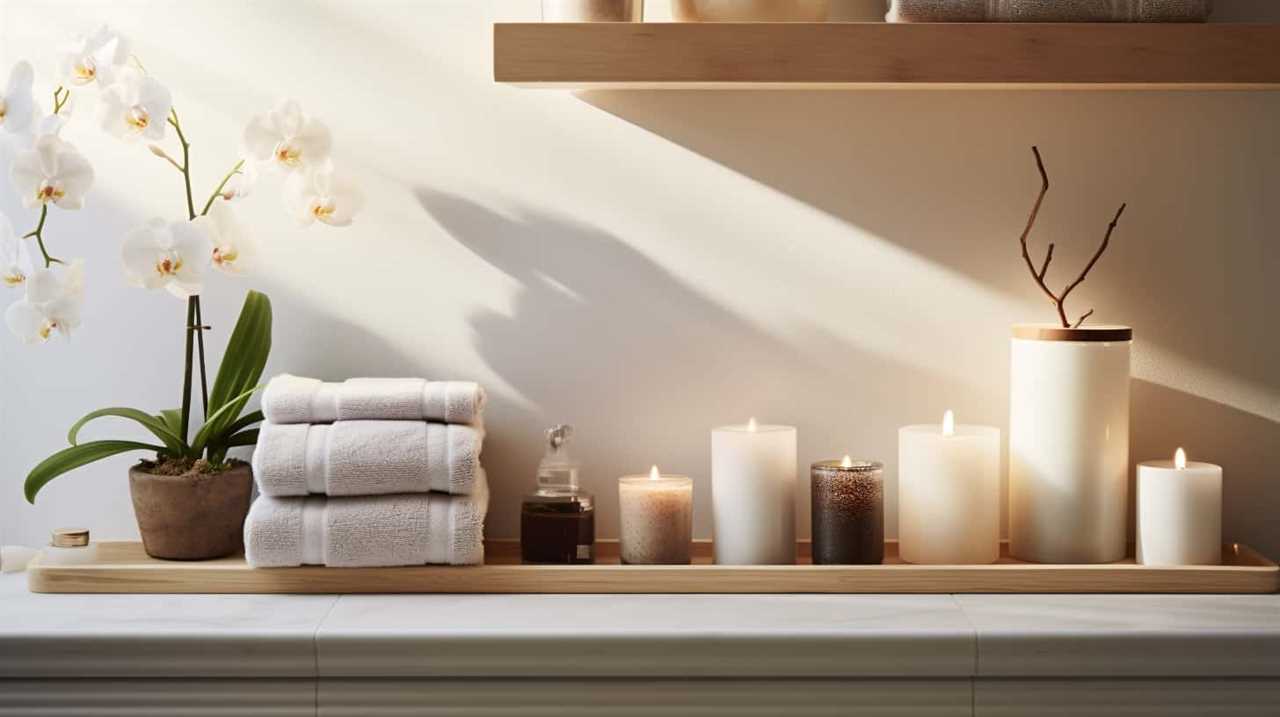
- Essential Oil Spray:
- Mix 1 cup of water with 10-15 drops of your favorite essential oil in a spray bottle.
- Shake well before each use and spritz around your home to create a pleasant aroma.
- Citrus Peel Potpourri:
- Save citrus peels from oranges, lemons, or grapefruits.
- Place the peels in a small pot with water and simmer on low heat.
- As the water evaporates, it will release a refreshing scent throughout your home.
Craft Supply Storage
One popular use for Bath and Body Works candle jars is as storage containers for craft supplies. These jars aren’t only beautiful, but they’re also practical and versatile.
They can be used to store a wide range of craft items, such as beads, buttons, ribbons, and paintbrushes. The clear glass allows you to easily see what’s inside, making it easier to find the supplies you need. You can also label the jars to further enhance organization.
The jars are durable and can withstand the demands of craft projects. They can be stacked or arranged on shelves to maximize space.
Travel-Sized Toiletry Containers
For a convenient and compact solution, try using Bath and Body Works candle jars as travel-sized toiletry containers. These jars aren’t only stylish and durable, but they’re also the perfect size for storing your favorite lotions and shampoos when you’re on the go.
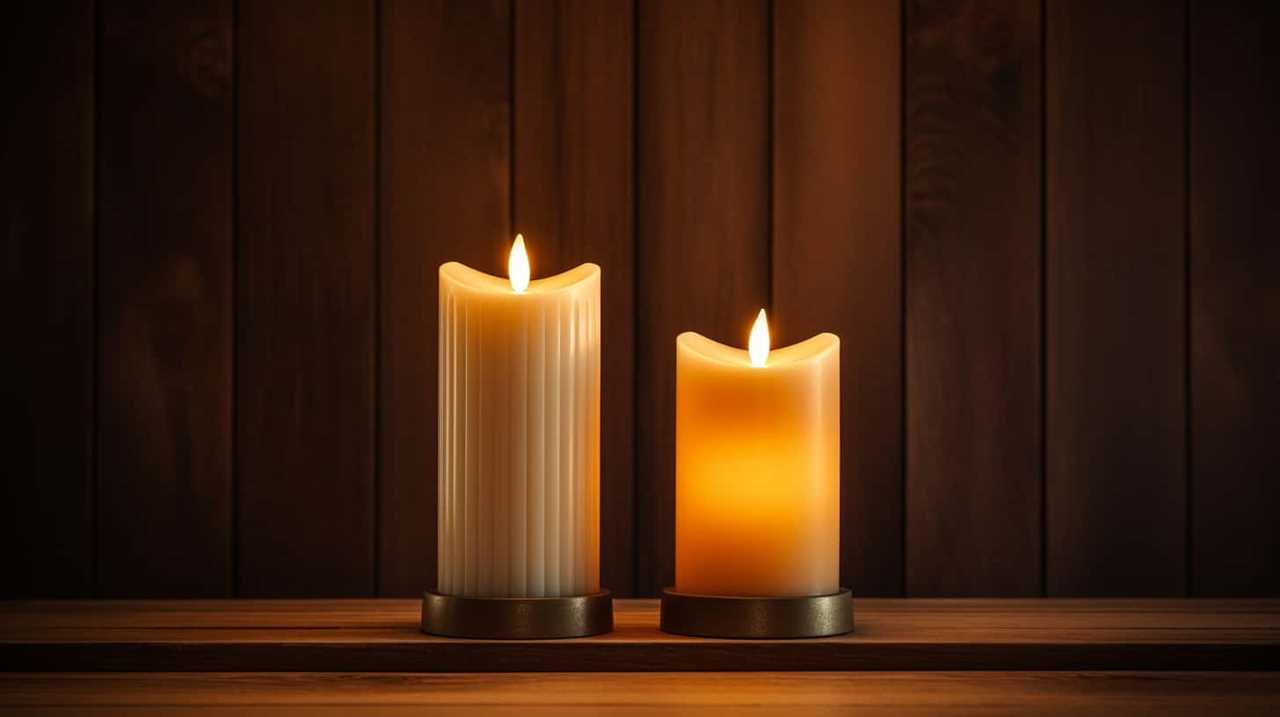
Here are some benefits of using these candle jars as travel containers:
- Versatility:
- Use them for travel sized lotion containers.
- Utilize them as portable shampoo bottles.
- Leak-proof design:
- The tight-fitting lids ensure that your toiletries won’t leak or spill in your luggage.
- Easy to pack:
- The small size of the candle jars makes them ideal for fitting into your carry-on or toiletry bag without taking up too much space.
By repurposing these candle jars, you can have your favorite products with you wherever you go, without the hassle of bulky and easily breakable travel containers.
DIY Bath Salts Jars
We can repurpose these Bath and Body Works candle jars to create our own DIY bath salts jars. Instead of throwing away the empty candle jar, we can transform it into a beautiful and functional container for our homemade bath salts.
To make our own DIY bath salts jars, we’ll need a few simple supplies such as Epsom salt, essential oils, and dried flowers or herbs for added fragrance and visual appeal.
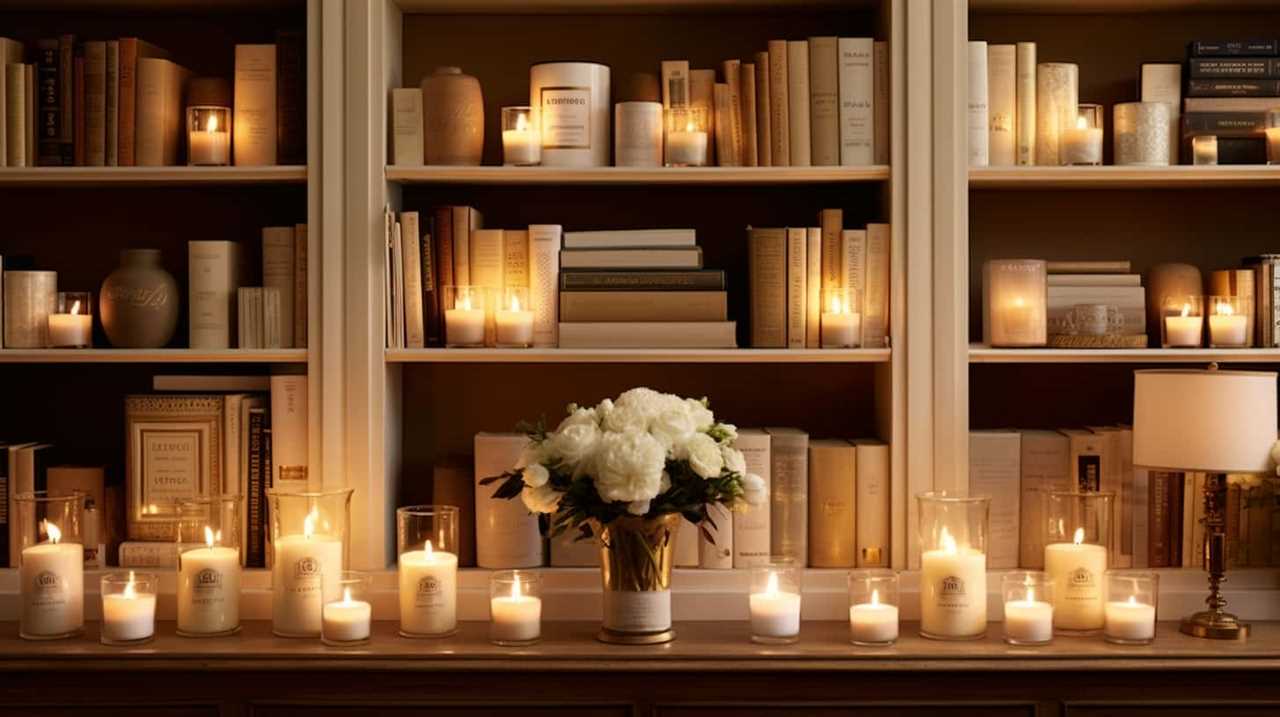
First, we need to clean out the candle jar thoroughly by removing any remaining wax and washing it with warm soapy water. Once the jar is clean and dry, we can fill it with our homemade bath salts mixture and decorate the lid with a label or ribbon.
These DIY bath salts jars can also be used as diy bath bomb molds or homemade body scrub containers, providing us with endless possibilities for our self-care routine.
Homemade Lip Balm Containers
To repurpose these Bath and Body Works candle jars, let’s repurpose them again as homemade lip balm containers. With a little creativity, these jars can become the perfect storage solution for your homemade lip balms. Here are two ways you can repurpose them:
- Homemade Lip Scrub: Fill the jar with a mixture of sugar and coconut oil to create a natural and exfoliating lip scrub. Simply apply a small amount to your lips and gently massage in a circular motion. Rinse off with warm water and enjoy smooth, soft lips.
- Natural Homemade Deodorant: Make your own deodorant by melting a combination of coconut oil, shea butter, baking soda, and essential oils. Pour the mixture into the candle jar and let it solidify. Apply a small amount to your underarms for a fresh and chemical-free deodorant option.
Jewelry Organizers
Let’s talk about some creative ways to repurpose Bath and Body Works candle jars as jewelry organizers.

One idea is to turn the jar into a necklace hanger by attaching small hooks or a piece of twine inside the lid.
Another option is to use the jar as an earring storage solution by placing a piece of mesh or a small corkboard inside and sticking the earrings through the holes.
Lastly, you can transform the candle jar into a bracelet display by filling it with decorative stones or beads and arranging your bracelets around them.
Candle Jar Necklace Hanger
For organizing our necklaces, we can repurpose Bath and Body Works candle jars as hangers. Not only does this help us keep our jewelry organized, but it also adds a touch of creativity and uniqueness to our space.
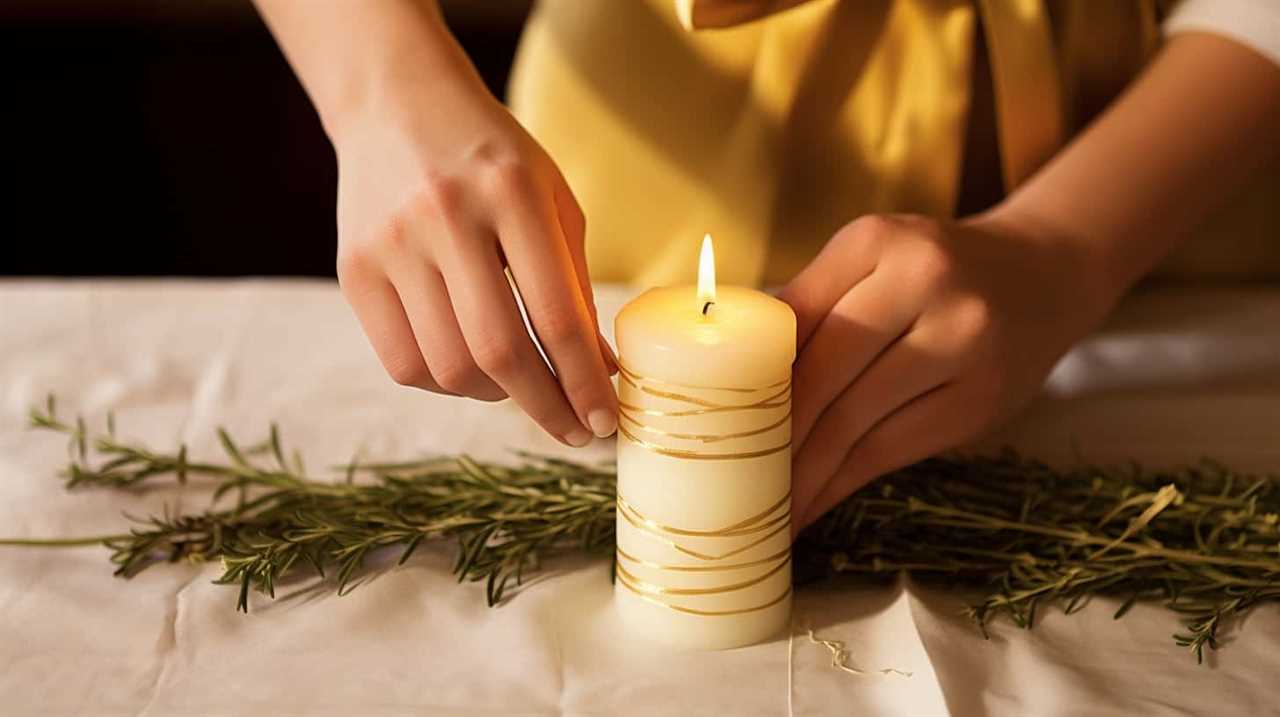
Here are a couple of ideas on how to turn candle jars into necklace hangers:
- Candle Jar Terrarium: Clean out the candle jar and remove any leftover wax. Fill the jar with small pebbles or sand, and then place a small succulent or air plant inside. Attach small hooks or loops to the rim of the jar to hang your necklaces from. This not only serves as a functional necklace hanger, but also doubles as a cute terrarium for your space.
- Candle Jar Pendant: Remove the lid of the candle jar and attach a chain or cord to the top of the jar, creating a pendant. This allows you to hang the jar from a hook or nail, creating a unique and eye-catching necklace hanger.
Earring Storage Solution
While repurposing Bath and Body Works candle jars, we can create an efficient earring storage solution by utilizing jewelry organizers. These organizers not only keep your earrings organized but also provide an attractive display for your jewelry collection.
One creative idea is to use a multi-tiered jewelry stand as an earring display. This stand typically has multiple rows or columns where you can hang your earrings, allowing you to easily see and access them.
Another option is to use a jewelry tray with compartments. This tray can hold different types of earrings, such as studs, hoops, and dangles, in separate sections, keeping them organized and preventing tangling.

By repurposing candle jars and incorporating jewelry organizers, you can create a functional and visually appealing earring storage solution.
Now, let’s move on to the next section to explore a bracelet display idea.
Bracelet Display Idea
We often use jewelry organizers to create a functional and visually appealing earring storage solution when repurposing Bath and Body Works candle jars. But why stop at earrings? With a little creativity, these candle jars can also be transformed into beautiful bracelet display ideas.
Here are some practical and creative ways to organize and display your bracelets:
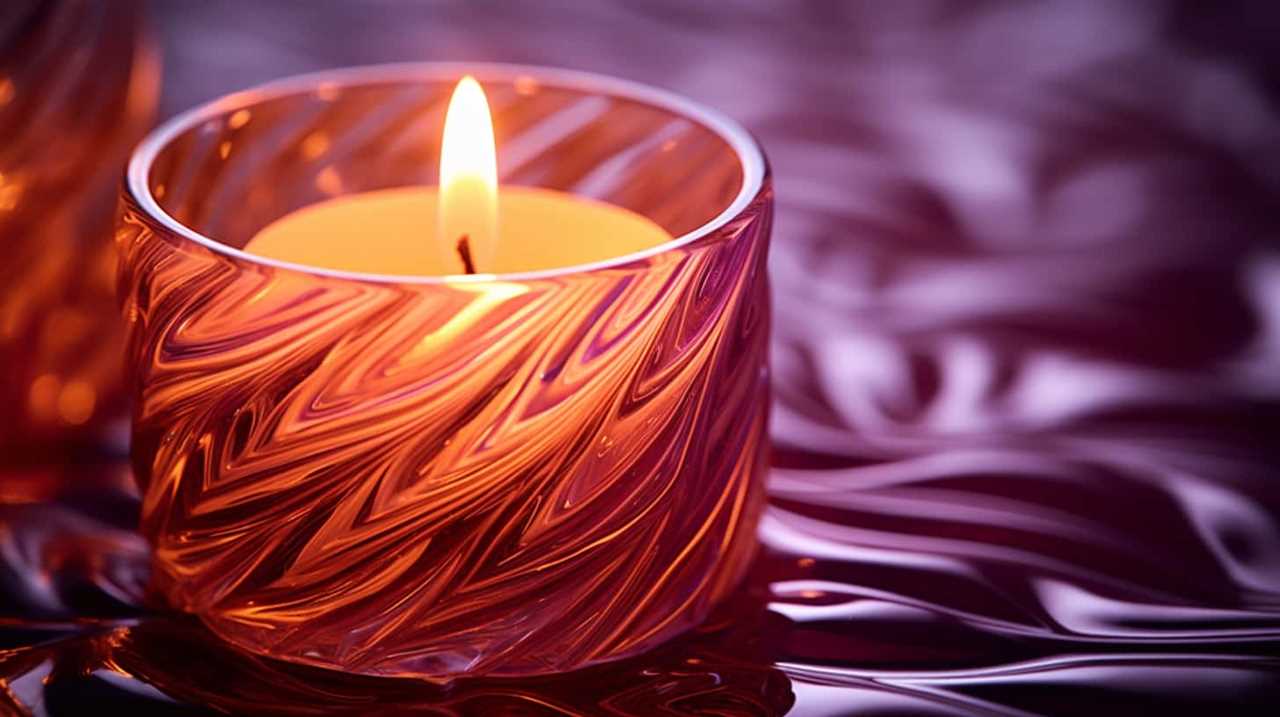
- Stackable Bracelet Holder: Use a small dowel or rod to create multiple levels within the jar. Simply slide your bracelets onto the dowel, allowing them to hang freely and stay organized.
- Bottle Bracelet Stand: Repurpose a small glass bottle by placing it inside the candle jar. Fill the bottle with sand or decorative beads and insert your bracelets onto the bottle’s neck. This will create a stylish and functional bracelet display.
Kitchen Storage Jars
To repurpose Bath and Body Works candle jars as kitchen storage jars, we can easily remove any remaining wax residue and clean them thoroughly. These jars can be a great addition to your kitchen organization and pantry storage. Here’s a simple step-by-step guide to repurposing these candle jars:
- Remove any remaining wax:
Place the jar in the freezer for a few hours. Once the wax hardens, use a butter knife to pry it out. - Clean the jar:
Fill the jar with hot water and a few drops of dish soap. Let it sit for a few minutes, then scrub the inside with a sponge or brush. - Rinse and dry:
Rinse the jar thoroughly to remove any soap residue. Allow it to air dry completely before use.
Now, you can use these clean candle jars to store various kitchen essentials like spices, herbs, nuts, or even homemade sauces. Get creative and label the jars for easy identification. Enjoy your newly organized kitchen!
DIY Room Diffusers
For creating DIY room diffusers with Bath and Body Works candle jars, we’ll need a few additional materials. Here’s what you’ll need:
- Reed diffuser sticks: These are thin, porous sticks that absorb and release the fragrance into the air.
- Carrier oil: Choose a light and odorless carrier oil, such as sweet almond or fractionated coconut oil, to dilute the essential oils.
- Essential oils: Select your favorite scents to create a unique fragrance blend for your room diffuser.
- Homemade room sprays: Another option is to make room sprays using the candle jars.
- Distilled water: This will be used to dilute the essential oils.
- Witch hazel or vodka: These act as emulsifiers and help the essential oils mix with water.
To make the DIY reed diffusers, simply fill the candle jar with the carrier oil and add a few drops of your chosen essential oils. Insert the reed diffuser sticks into the jar, and they’ll gradually release the fragrance into the room.

For homemade room sprays, combine distilled water, witch hazel or vodka, and essential oils in a spray bottle. Shake well before use.
Now that we’ve explored DIY room diffusers, let’s move on to the next topic: DIY gift containers.
DIY Gift Containers
Let’s explore some creative ways to repurpose Bath and Body Works candle jars into unique gift containers.
Not only will this save you money, but it’s also an eco-friendly option that repurposes items you already have.
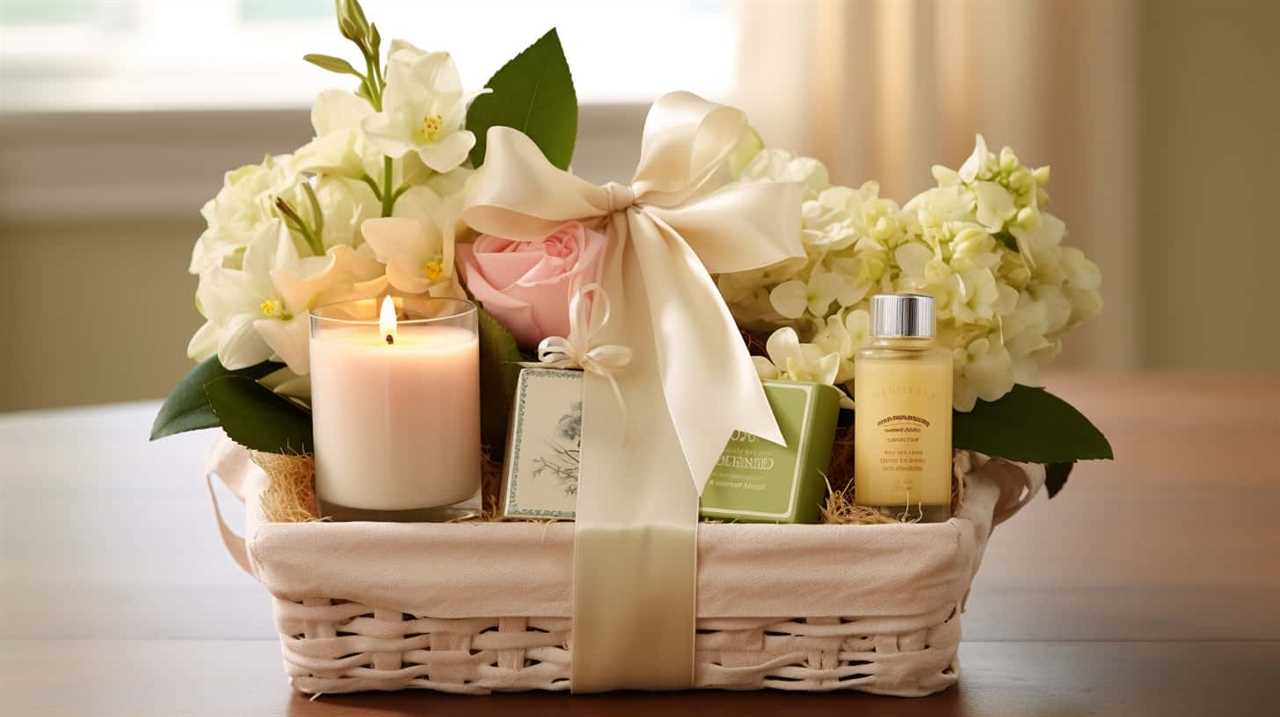
From creating personalized spa kits to filling them with homemade treats, these DIY gift containers are a cost-effective solution that adds a special touch to your presents.
Creative Repurposing Ideas
After reusing Bath and Body Works candle jars, we can repurpose them into creative DIY gift containers.
These versatile jars can be transformed into unique and stylish containers for various gifts.
Here are some creative repurposing ideas for your candle jars:
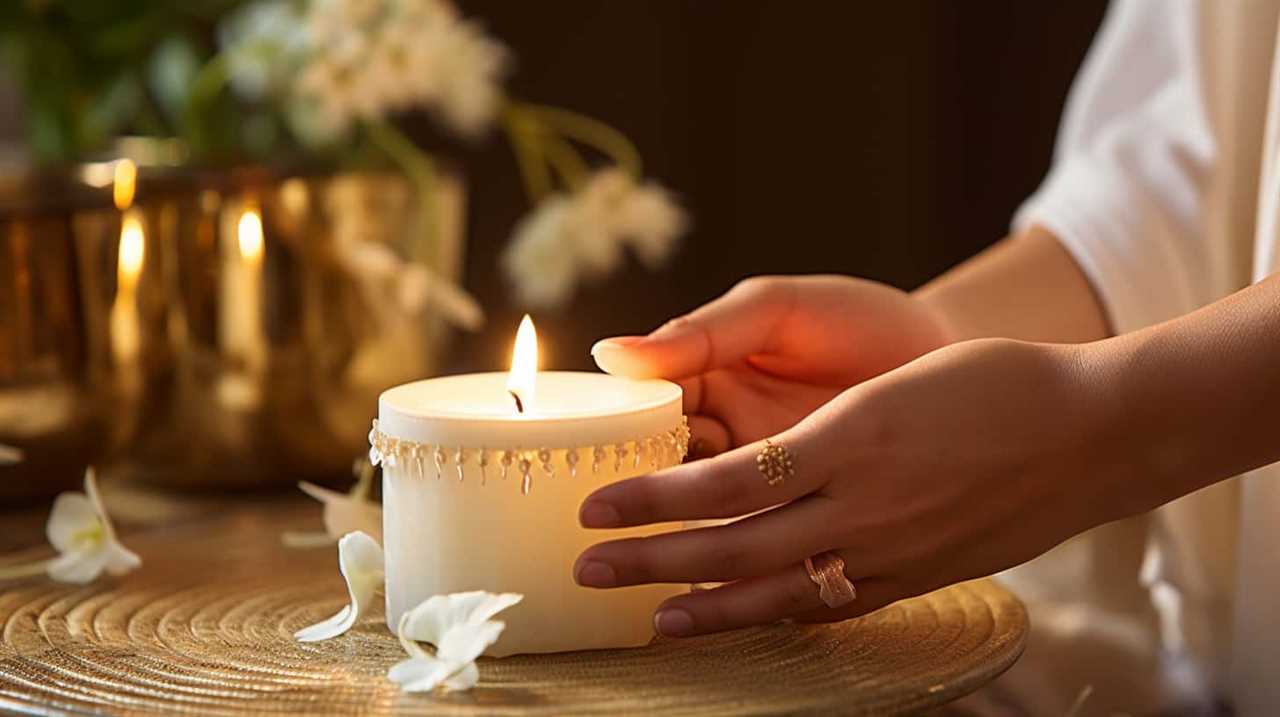
- Makeup Brush Organizer: Clean the jar thoroughly and remove any remaining wax. Fill the jar with small pebbles or beads to create a stable base. Then, insert your makeup brushes into the jar, allowing them to stand upright. This not only organizes your brushes but also adds a touch of elegance to your vanity.
- Repurposed Glass Bottles: Remove the candle label and clean the jar. Fill it with colorful sand or decorative stones. Place a small bouquet of flowers or a single stem inside for a charming centerpiece or gift. You can also use these repurposed jars as elegant vases for fresh or dried flowers.
With a little creativity, these candle jars can become stunning DIY gift containers that are both practical and beautiful.
Eco-Friendly Gift Options
To create eco-friendly gift options, we can repurpose Bath and Body Works candle jars into stylish and practical DIY gift containers. By upcycling these jars, we can contribute to eco-friendly packaging and sustainable gifting options.
The sturdy glass jars of Bath and Body Works candles make perfect containers for homemade gifts such as candles, bath salts, or even small plants. After thoroughly cleaning the jars, you can decorate them with ribbons, labels, or paint to add a personal touch.
Not only are you reducing waste by reusing these candle jars, but you’re also creating unique and thoughtful gifts that your loved ones will appreciate.

Now, let’s explore some cost-effective DIY solutions for creating gift containers.
Cost-Effective DIY Solutions
To create cost-effective DIY gift containers, we can repurpose Bath and Body Works candle jars into stylish and practical options. Here are some creative ideas for repurposing these jars:
- Mason Jar Herb Garden: Clean out the jar and fill it with soil. Plant your favorite herbs and use it as a cute and functional addition to your kitchen.
- DIY Bath Salts: Remove the label, clean the jar, and fill it with a homemade bath salt mixture. Add dried flowers or essential oils for a personalized touch.
- Bonus Tip: Tie a ribbon around the jar and attach a small wooden spoon for easy scooping.
Repurposing candle jars not only saves money but also adds a touch of DIY home decor to your space. With a little creativity, you can transform these jars into budget-friendly organization solutions or unique gifts for your loved ones.
Frequently Asked Questions
Can I Use the Bath and Body Works Candle Jars for Storing Food Items in the Kitchen?
We can repurpose Bath and Body Works candle jars for organizing kitchen utensils or using them as plant pots. However, it is not recommended to use them for storing food items in the kitchen due to potential health risks.
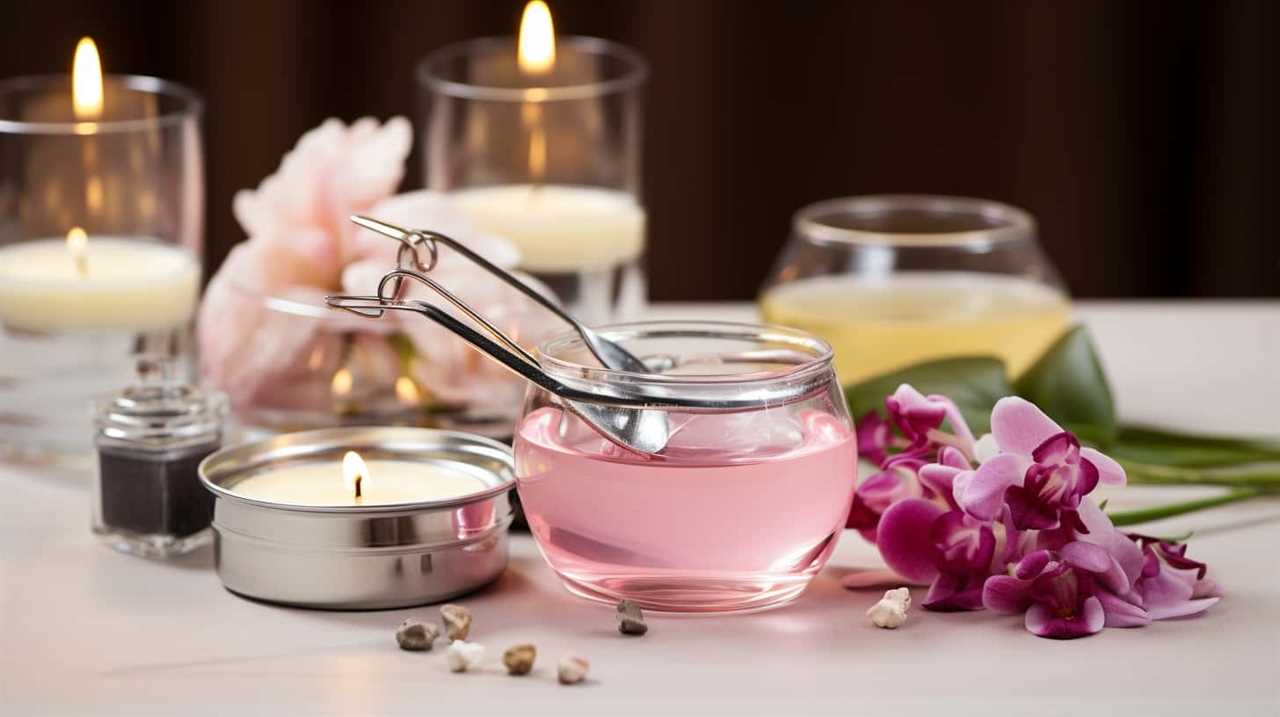
How Do I Remove the Label From the Candle Jar Without Damaging It?
To remove the label from the candle jar without damaging it, we gently peel it off or soak the jar in warm, soapy water. Then, we can reuse the jar for creative storage ideas like organizing beauty products or crafting supplies.
Can I Use the Candle Jars as Candle Holders for Other Types of Candles?
Yes, we can definitely repurpose Bath and Body Works candle jars as candle holders for other types of candles. For example, we can use them to hold homemade soy candles for a cozy and personalized touch.
Are the Candle Jars Safe to Use in the Microwave or Oven?
Microwave and oven safety should always be a top priority. When it comes to reusing Bath and Body Works candle jars, it’s important to note that these jars are not safe for use in the microwave or oven.
Can I Use the Candle Jar as a Pen or Pencil Holder for My Desk?
Sure, we can definitely use the candle jar as a pen or pencil holder for our desk. It’s a practical and creative way to organize our workspace while adding a touch of elegance.

Conclusion
In conclusion, with a little creativity and resourcefulness, the possibilities for reusing Bath and Body Works candle jars are endless.
From transforming them into makeup brush holders and mini planters to organizing your bathroom, office, and jewelry, these jars can be repurposed in various ways.
They can even serve as kitchen storage jars and DIY room diffusers.
Let your imagination run wild and give these jars a new lease on life, turning them into beautiful and practical pieces for your home.


